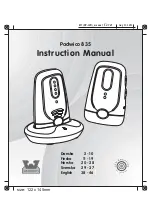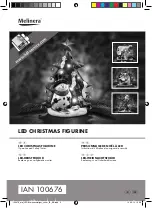
Z4W-V
Z4W-V
7
Axis Adjustment
When the Sensor power is switched ON, the red transmitter indica-
tor is lit. Move the Sensor so that the red beam (see the figure below)
focuses on the object. The entire light beam should be focused on
the object or an error will result.
Surface
of object
Spot
Correct
Incorrect
After the optical axis has been adjusted, tighten the mounting
screws firmly.
Connecting a Z4W-DD1C Linear Sensor Control-
ler
To discriminate among objects according to size, use the
Z4W-V25R LED Displacement Sensor with a Z4W-DD1C Linear
Sensor Controller.
ÉÉÉ
ÉÉÉ
ÉÉÉ
ÉÉÉ
ÉÉ
ÉÉ
ÉÉ
Tolerance
Output
Output
NG
ON
OFF
ON
OFF
PASS
The following equipment is required:
•
Z4W-V25R LED Displacement Sensor
•
Z4W-DD1C Linear Sensor Controller
•
Synchronization Sensor (E3X Fiber Photoelectric Sensor or
E3C-VM Miniature Head Photoelectric Sensor is recommended)
•
An object of standard dimensions
•
An object of threshold dimensions
•
Tools
Mounting
Mount as described on page 6.
When installing a Synchronization Sensor, refer to the instruction
manual and read the precautions for the model. It is important to in-
stall the Synchronization Sensor so that the LED Displacement
Sensor can detect the object at the measurement position. Do not
tighten the mounting screws for the moment since the optical axis
must be adjusted.
The Z4W-DD1C Linear Sensor Controller can be mounted on a wall
and secured with screws, or mounted to DIN rail.
Wiring
Make sure that the Linear Sensor Controller, the LED Displacement
Sensor, and the Synchronization Sensor are wired correctly before
turning on the Linear Sensor Controller power (power is supplied to
the LED Displacement Sensor and the Linear Sensor Controller by
the Linear Sensor Controller). To avoid trouble, leave the output ter-
minals (No. 4, 5, 6) of the Linear Sensor Controller open for the mo-
ment.
Z4W-DD1C
Synchronization
sensor
Z4W-V25R
4 to 20 mA Black
0 V
+12 V
0 V
4 to 20 mA
100 mA
30 VDC
Max.
FG
100 to 240 VAC
50/60H
Z
+12 V Brown
DARK output
Orange
0 V Blue
Shield
0 V Blue
Output
Black
12 V Brown
Axis Adjustment
After adjusting the optical axis of the LED Displacement Sensor, ad-
just the optical axis of the Synchronization Sensor so that the LED
Displacement Sensor detects the object at the measurement posi-
tion in synchronous operation. Since the Linear Sensor Controller
operates synchronously on receiving each output signal of the Syn-
chronization Sensor, set the position of the Synchronization Sensor
so that the front edge of the object is detected by the Synchroniza-
tion Sensor.
Synchronization
sensor
Surface of
object
Displacement
sensor
After the optical axis has been adjusted, tighten the mounting
screws and secure the Synchronization Sensor firmly. Some Syn-
chronization Sensor models incorporate a sensitivity controller. For
the adjustment of such models, refer to the instruction manual for
the Synchronization Sensor.






























